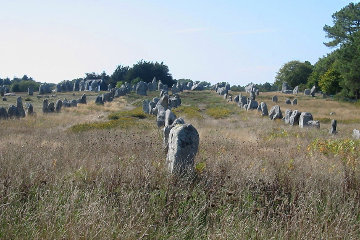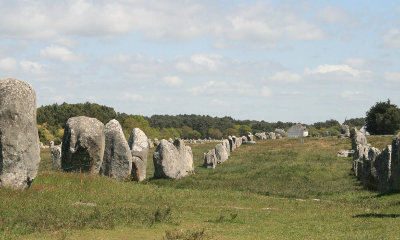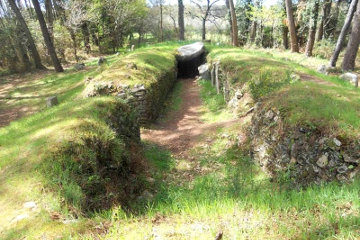The Mysterious Lines of Carnac
| The Menec Alignment | 47 35 33.22N 03 04 58.29W | 11 lines of stones 3,822 feet long. The western stones are as much as 13' high, while those towards the middle are as small as 2' high. There are 1,100 stones in all. |
| The Kermario Alignment | 47 35 48.41N 03 03 56.23W | 10 lines of stones, 4,300 feet long. There are 1,029 stones in all. |
| The Kerlescan Alignment | 47 36 16.32N 03 02 54.80W | 13 lines of stones, 2,600 feet long. The stones range from 2'7" to 1" in height. |
Some years ago my family and I toured France and in particular explored the Brittainy peninsula. Our last visit, before heading towards the south of France, was to Carnac, about which we knew very little but we had seen photographs of the site and were fascinated by it.
In those days we camped and as we headed south across the width of the peninsula we kept our eyes open for a camp ground, but mile after mile went by, town after town, and there simply was no camp ground. In the end, with darkness falling and the children growing fretful, we had to "savage camp" - a term we coined from the French "sauvage", for various places warned us that "sauvage" camping was strictly "interdite". We passed the night without any disaster following and rose early, both to avoid the attention of the authorities and because we particularly wished to view Carnac at sunrise.
We duly arrived at the site - and there was still no camp ground - and wandered round it in the pre-dawn gloom. Gradually a few other like-minded tourists appeared and gathered at the western end of the stones and I can confirm to you that on that morning, at least, the sun rose in the east. I can also confirm that the long lines of stones also pointed, in a general sort of way, towards the rising sun. We took a few photographs and then departed, feeling just slightly cheated that such a spectacular site should be so little provided with information and facilities for the visitor.

| |
| Stones of the Kermario Alignment appear crowded together in this telephoto view. |
If you have never heard of Carnac before, then I recomment you copy and paste the coordinates given above into Google Earth, where you can not only look down on the stones from above - something we could not do when we visited - but there are numerous photographs of the three main alignments, together with other photographs of the tumuli, cromlechs and menhirs that dot the landscape.
The main thing you will notice is that the the three main alignments all face in different directions! Menec is roughly ENE, Kerlescan is definitely NE, while Kermario is ESE. Accessed by winding roads and viewed from the ground, this fact was not easily apparent - we would have had to have a compass with us to notice it - and so we gave credence to the tourist leaflets we picked up which asserted that the stones were lined up to face the rising sun. (Or, of course, the setting sun!) As the direction of sunrise varies throughout the year, we were not perturbed by the fact that on the day of our visit, the stones were not precisely aligned with the rising sun.
The first "scientific" investigation of the stones was by James Miln, a Scottish antiquary, who noted that fewer than 700 of the over 3,000 stones were standing in their original positions. Like any other group of people, the farmers of the area were using the alignments as a convenient quarry and there are even reports of the cromlechs being used as ovens! Miln worked according to the best practice of his time and his work was carried on by a local, Zacharie le Rouzic, who felt compelled to put his mark on the site by erecting his own menhir, a 21' tall stone at Kerlescan!

| |
| The rows of the Menec Alignment stretch towards the house built right in the middle! |
Subsequently the French government experts from the Ministry of Culture have taken the site in hand, trundling all over the alignments with bulldozers and other heavy lifting equipment to raise many of the stones. Having thus destroyed whatever archaeological remains there might be, the government then erected a fence around the site to "prevent damage by tourists"! The same experts then introduced sheep into the enclosures to keep the grass down, completely oblivious to the fact that the sharp hooves of sheep will do more damage to the ground than a generation of tourists!
Little wonder that in 2002 the "Everyone Together Collective" invaded the site, took over the Visitor Centre, broke open the padlocks and let the tourists in and the sheep out. Given the French penchant for impromptu roadside barbeques of English sheep, one cannot help but wonder how many of the unfortunate bovines made it home again!
Even before the uncultured Ministry of Culture brought their bulldozers in, the results of excavations were disappointing. The stones appear to have been erected on virgin soil, so the amount of pottery associated with them is small and none has been found beneath the stones. What pottery has been found is of Neolithic date, but that could be anywhere between 4500 BC and 2000 BC. By convention, the stones are dated to 3,300 BC, but no one claims that that is the actual date of Carnac's construction.

| |
| One of the many tombs at Carnac. The burial chamber has been uncovered. |
In fact, the date may depend on the purpose of the alignments. The earliest local legends are that the long lines of stones were Roman legionaries, turned to stone by Merlin or Pope Cornelius. Slightly less improbable is the tourist brochure theory that they were an astronomical observatory to enable druids or other ancient religious functionaries to calculate various important dates - harvest, summer solstice, lunar eclipses, or what-have-you.
Completely off the wall are the ideas by some French "expert" who, after thirty years of study, confidently announced that the lines were seismic instrucments and that the cromlechs were earthquake detectors. (As a general rule, the best guide to whether an earthquake is taking place is the shaking of the ground.) As an example of this gentleman's muddled thinking, Wikipedia quotes from page 60 of his work, "Stones for the Living":
"The heavy tables of these monuments with their dizzying overhangs must have devilishly balanced on their three feet, at the slightest shock. As an earthquake observation station, we could not do better today."
Quite so.
The trouble with the astonomy theory is that, as observed above, the alignments face in three different directions and while it is not impossible that, after years of lining up the stones to face one way, there was a religious revolution and the Neolithic people suddenly decided that actually they should be marking a different day and a different direction altogether, it is, in my opinion unlikely.
In any case, if you wish to mark the direction of the rising (or setting) sun, all you need is two quite short rows of stones, very close together, not the eleven or thirteen rows of stones thousands of feet long and many yards apart, which is what you actually get.

| |
| The largest tumulus actually has a chapel to St Michael built on top of it! |
Given the large number of other tombs and burial chambers in the vicinity, therefore, I incline towards the idea that the alignments have a funerary purpose. So far as excavation has shown, there are no burials directly associated with the alignments. Rather than being gravestones, the stones are memorials. Important people might be buried in a cromlech or tumulus at this sacred site, but lesser people, buried elsewhere, could nonetheless be commemorated by a stone dragged into position and erected by the family. Those with big families might put up one of the larger stones; those who were survived by only a few family members had to be content with a smaller stone.
The fact is, however, that we simply do not know why these stones were dragged to these sites and lined up in long rows. About the only thing we can be sure of is that if you are interested in a bit of mystery, you should make a trip to Brittany and view the stones before the officials at the Ministry of Culture have another brainstorm and sent in the bulldozers again.
© Kendall K. Down 2014





